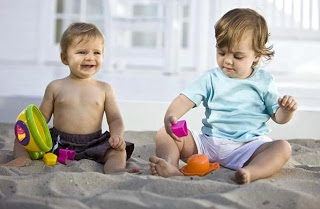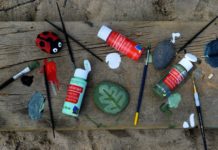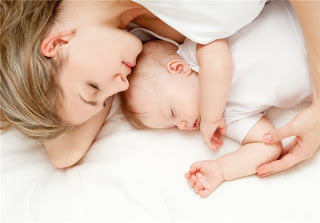
Lack of education, being stupid, being selfish, as well as following outdated advice from elder generations can lead to parents ‘abusing the bottle’. Read on to discover why putting anything other than breastmilk or formula in your baby’s bottle is not only dangerous; it also makes you look like a prick.
Tea in Babies Bottles
The totally unbiased UK Tea Council has chirped, “It’s never too early to introduce your children to the pleasures of drinking tea.” We’re talking non-herbal bog-standard tea here. Giving a baby tea in a bottle is pretty grim. Apart from looking rough as a badger’s chuff, it is also unadvisable for a host of reasons.
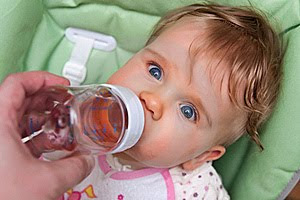
The most obvious is caffeine. Why anyone would ever want to give their baby a stimulant beats me. Any beverage containing caffeine can inhibit sleep. Also, because caffeine is a strong diuretic, it can lead to dehydration. Sleepless nights and bedwetting – great things to look forward to. Furthermore, caffeine is known to act on the central nervous system, increasing heart rate and blood pressure. It is such a powerful stimulant that attempts to stop consuming it can produce symptoms of withdrawal.
Some parents assume decaf tea and green tea are safe alternatives to caffeinated tea. However, “it is impossible to determine how much caffeine is in a given cup of tea purely on the basis of the type of tea. Several factors, including how the tea was grown, soil, processing, and preparation determine how much caffeine is in a given tea” (Petersen, The Health Risks of Decaf Tea).
Even if a parent was to know the exact caffeine content of their baby’s bottle of tea (see, even typing it looks gross), there is the pertinent issue of mineral absorption. Tea contains a substance called tannin which inhibits the body’s ability to absorb minerals like iron, calcium and zinc from food (BBC, Weaning). These minerals are necessary for the healthy function of your baby’s immune system and digestion. A lack of such minerals can lead to conditions such as iron deficiency anaemia, which can lead to failure to thrive. Not something you want stamped on your baby’s red book.
Tannin is also responsible for staining the teacup, the teapot, and of course, babies bottles. The most common victims of tannin staining are babies’ humble tooty pegs. It is hardly surprising that tannin discolours teeth when you consider that it is used in the chemical staining of wood.
I know what you’re thinking, “This is feel good stuff”; But wait, there’s more. It has been suggested that tannin increases the risk of nasal and esophageal cancer (Elvin-Lewis et al 1977, Medical botany: plants affecting man’s health; Nutrition Health Review, Tannin Linked to Esophageal Cancer; Hung et al 2004, Association between diet and esophageal cancer in Taiwan; Wang et al 2007, Diet habits, alcohol drinking, tobacco smoking, green tea drinking, and the risk of esophageal squamous cell carcinoma in the Chinese population; Barclay 2009, Hot Tea Consumption Linked to Higher Risk for Esophageal Cancer).
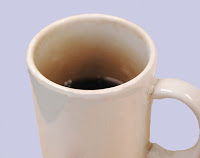 Even decaffeinated tea contains tannin. So the tea doesn’t have to be hardcore Yorkshire Tea that you can stand a spoon up in; it can be weak decaf and still pose health risks to your baby. In 2008 the Government considered banning the serving of tea in schools due to tea’s “minimal nutritional benefits” (The Telegraph, Schools Face Ban on Serving Tea to Under-16s). Babies that drink tea lose out on the fat and calories in breastmilk/formula that are essential for growth and development because the tea gives them less desire for their milk. As for parents who put sugar in their babies’ tea, they need a stern bollocking from a health visitor; But they’ve got nothing on parents who practice the following…
Even decaffeinated tea contains tannin. So the tea doesn’t have to be hardcore Yorkshire Tea that you can stand a spoon up in; it can be weak decaf and still pose health risks to your baby. In 2008 the Government considered banning the serving of tea in schools due to tea’s “minimal nutritional benefits” (The Telegraph, Schools Face Ban on Serving Tea to Under-16s). Babies that drink tea lose out on the fat and calories in breastmilk/formula that are essential for growth and development because the tea gives them less desire for their milk. As for parents who put sugar in their babies’ tea, they need a stern bollocking from a health visitor; But they’ve got nothing on parents who practice the following…
Rusks in Babies’ Bottles
Some parents put rusks into their baby’s bottles in an effort to thicken up the milk so their baby sleeps longer/is satisfied for longer/looks cute/whatever. In my opinion putting rusks into babies’ bottles thickens up the contents so that the milk matches the parent. The practice stems from outdated advice circa 1970 and can be extremely dangerous.
Not only is it nonsensical to put rusks into bottles, it is tantamount to force feeding. In order to get the milk, the baby has to take the solid matter too. Thus, baby does not get their thirst quenched without having to consume the extra calories contained in the rusk. If baby cried later because they were still thirsty, their parent may interpret this as more hunger, and propagate a vicious circle. The baby would become dehydrated due to taking in inadequately diluted fluid; and because rusks raise the sodium content of the milk, their tiny kidneys would become overloaded. The unfortunate baby would not get their thirst quenched but would be getting fatter and fatter, and their tiny stomach would become stretched. Then the baby’s appetite would grow in accordance with their stretched stomach and produce genuine hunger pangs (Leach, Your Baby and Child: From Birth to Age Five).
One reason rusks are so calorific is because they contain copious amounts of sugar. Rusks contain more sugar than chocolate digestives (The Independent, 2009). They are “more unhealthy than junk food” (The Times, 2009). There is 3.5g of sugar in a reduced sugar rusk, and 4.9g of sugar in a regular rusk. Next time you see a box of rusks, check out the small print. There is no natural nutrition; the main ingredient is flour. The other main ingredient is… you guessed it – sugar! The vitamins you see touted in marketing by Heinz and Co are artificially added to entice parents to buy the product. Our bodies are designed to absorb and digest natural vitamins and minerals; artificial man-made ones are much harder to process. On the topic of man-made substances, a popular mainstream brand of rusks was even found to contain weed killer (UK Food Standards Agency, 2006). How thoughtful of Heinz.
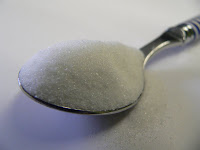
Back to the issue of sugar; an obvious danger of the high sugar content of rusks is the effect on teeth, and this issue is exacerbated by putting rusks in babies’ bottles. Liquid flows slowly through a bottle teat and sits in a baby’s mouth for longer than it would in a cup, thus leading to rotting teeth and ulcers. Furthermore, even if a baby does not have visible teeth yet, the acidity of their saliva (caused by sugars from the rusk feeding the bacteria) can damage the teeth while they are still in the gums. Babies have teeth, even if you cannot see them.
Some parents argue that tooth decay in babyhood is not a concern because all baby teeth fall out eventually regardless of tooth care. However this is an ignorant attitude. If a baby tooth is lost too early, the teeth beside it may drift into the empty space. When it’s time for the adult teeth to come in, there may not be enough room. This can make the teeth crooked or crowded (American Dental Association).
Another reason why putting rusks into babies bottles is irresponsible is the risk of choking. Bottles are designed for a runny liquid to come from them, not a gloopier mess. Some parents who give rusks in bottles argue that the choking risk is minimal. Their reasoning is that if the substance was small enough to fit through the teat of bottle, it is unlikely to choke a baby. However even teats designed with larger holes do not prevent the choking hazard. Lumps aside, the thick liquid can be aspirated into the baby’s lungs and cause serious problems.
As well as turning their babies into fatty bunters, dehydrating them, rotting their teeth and putting them at considerable risk of choking, parents who put rusks into bottles also increase their babies’ likelihood of developing allergies. Most rusks contain gluten which, if given to babies under six months, is a prime instigator of allergies and coeliac disease. Symptoms of the latter include chronic diarrhoea, abdominal pain, weight loss, failure to thrive, fatigue, and mouth ulcers. Not great gifts for your baby.
At this point, you may be wondering why parents continue to crush up rusks and place them into their babies’ bottles notwithstanding the substantial health risks involved. One of the main reasons is tradition. As the practice was common in the 70s, contemporary Rusk Parents like to retort “They did it years ago and we’re all okay”. When I hear this excuse/argument I find so irritating that it feels like a cheese grater on my brain. So many parents use it to justify outdated practices. There’s a simple reason why the “we’re all okay” argument is twaddle. Hands up, all those reading this blog who were fed solids in a bottle and choked to death or died of aspiration pneumonia. No-one? Before you accuse me of being unnecessarily extreme, consider the following scenario. What would you say to someone who slung a carrycot on the back seat of a car and drove off without strapping it in? They’re unlikely to have an accident, but if they do, it’s very likely to have devastating consequences.
In addition to tradition, another main culprit in Rusk Parents’ reasoning is the quest for more sleep. However this is misguided optimism. Babies do not sleep better because they are full. They sleep because they need sleep. Hunger is not the only reason babies wake. If a parent gets into the habit of giving food in a bottle, they are making a rod for their own back. As parents we all made the conscious decision to raise our babies and accepted significantly less sleep as part of the deal. So why are some parents so desperate to fill a baby up with total karp so they can get an extra hour or twos sleep? As well as rusks, such parents also like to employ…
Rice in babies’ bottles
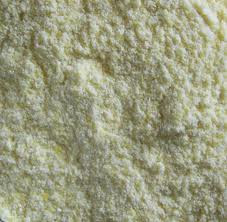
Putting baby rice, or as I like to call it – wallpaper paste, into babies’ bottles alongside their regular milk is common practice in some parts of Europe. However medical opinion maintains that if a baby is too young to take rice off a spoon it certainly should not be sucking it out of a bottle. Babies have tiny stomachs and need feeding little and often, not stuffing with food that’s gruelling for them to digest (Spare a thought for the Virgin Gut!) The claim that putting rice into a baby’s night time bottle will help them to sleep is a misconception. Studies have found that it makes little difference (NIH Medical Library – Study on Infant Sleep and Bedtime Cereal). Breast milk or formula has more fat per ounce than baby food, especially rice. In fact bottle feeding rice can make sleeping worse if the baby’s digestive system isn’t ready for it. The World Health Organization & the American Academy of Paediatrics concur with this and recommend that only milk be placed in babies’ bottles. On a practical note, the baby may have a hard time learning to eat from a spoon, if she gets used to taking solid foods in a bottle (Harvard Medical School, 2 Month Old Baby Care).
Furthermore, adding rice derails a baby’s “full up” mechanism. Like rusks, the practice forces babies to take in deceptively large amounts of calories. It teaches them to overeat. (Dr Greene, Baby Bottles and Cereal). Even more importantly, the sucking and swallowing actions are not fully coordinated in some babies, which can lead to pulmonary problems as they inhale rice partials into their lungs. This can have lethal consequences.
Aside from the important issues which arise from feeding rice through a bottle, the dubious benefits of baby rice as a food in itself have been called into doubt. A third of baby rice on sale in the UK has been found to contain so much inorganic arsenic, a human carcinogen, that it would be illegal in some countries (The Independent, 2006). This is because rice soaks up arsenic from the soil more readily than other grains do. Yet health visitors, GPs and dieticians will commonly recommend giving it as baby’s first food. Why? The reason is yet again, tradition. Giving baby rice has been received wisdom for 60 years as a result of baby food companies in the 1950s that “launched an advertising blitz trumpeting the benefits of white rice cereal. But there is no scientific basis for this recommendation. None at all.” (The Nutritional and Food Web Archive, 2010).
In reality white rice is a refined carbohydrate. Its highly processed nature means that fibre, vitamins and other nutrients have been stripped away and artificial nutrients added in their place. Reflux babies aside, there is no reason to give an infant baby rice (Kellymom, First Foods). Not only is the rice itself nutritionally devoid, but when added to breastmilk or formula it reduces the amount of milk in the bottle thus diluting the nutrient density, making each feed less nutritious in terms of calcium, other minerals, fats, and protein (Widome, Your New Baby and Sleep). The result is that baby may not get adequate milk volume for optimum growth and development; and as with rusks, the decreased milk volume can dehydrate a baby leading to constipation and illness.
Even more importantly, white rice has also been linked to increased rates of heart disease, insulin resistance, eye damage and cancer. Feeding infants baby rice can increase their risk of developing type 1 diabetes and can prime their appetite for a lifetime of processed carbs. It is a “nutritional disaster” (USA Today, 2010). Dr David Ludwig, a specialist in paediatric nutrition, suggests that baby rice is among the worst food for babies. He maintains that baby rice “digests very rapidly in the body into sugar, raising blood sugar and insulin levels and could contribute to later health problems, including obesity” (The Associated Press, Experts Seek to Debunk Baby Food Myths). Yet despite these publicised risks, baby rice continues to be the most common type of first food introduced to babies, with 57% of UK mothers giving it as their babies’ first introduction to solids (Infant Feeding Survey 2010).
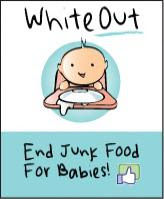
Renowned US paediatrician Dr Alan Greene has said that giving baby rice is no different than adding sugar to formula (ABC, Stanford Doctor Says White Rice Bad for Babies). He has launched the ‘WhiteOut’ campaign to encourage parents to ignore corporate marketing and wean their babies on natural food when their babies are ready.
Juice in babies bottles
It is hard to fathom anything more gross than seeing a bottle of juice propped up in a buggy or a toddler running around with a bottle of juice giving their teeth prolonged exposure. The bacteria in a baby’s mouth feed on the sugars found in the juice. These bacteria then produce acid as a by-product of their feasting. It is this acid which attacks the tooth enamel and causes cavities. Each time a baby drinks juice, the acids attack for 20 minutes or longer (The American Dental Association). Additionally, constant sugar in the mouth can lead to a build-up of bacteria to a point where more harmful types of bacteria start becoming predominant. These bacteria cause gingivitis by invading gum tissue and releasing toxins. In severe cases, the bacteria and their toxins can attack bone structures supporting the teeth (periodontal disease) resulting in permanent damage (Save Your Smile, How to Prevent Baby Bottle Tooth Decay).
Some parents argue that fruit juice is healthy because pieces of fruit are healthy. However there is no advantage to giving a baby juice instead of whole fruit. In fact, fruit juice lacks the important fibre that whole fruit contains. Both the UK Foods Standards Agency and the American Academy of Paediatrics state that you should not give babies juice before they are at least 6 months of age. It follows that if a baby is old enough to drink juice then they should be old enough to use a beaker rather than having the juice in a bottle.
In 2006 a toy company called Dolls World created artificial milk and juice bottles for baby dolls:
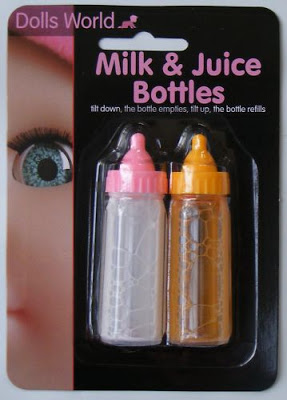
After receiving complaints (probably from Alpha Parents!) the company redesigned the juice bottle into a juice beaker:
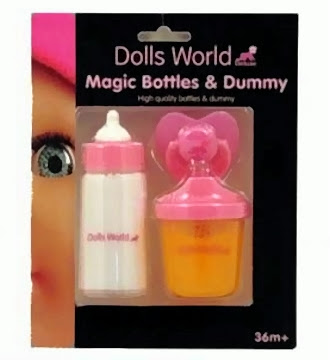
A number of parents believe that diluting juice makes it tooth-safe. Although diluting reduces the sugar content it does not affect the pH (acidity). Juice in a bottle, whether natural or artificially sweetened, whether diluted or not, is one of the big dental health no-nos. It keeps the liquid in contact with the teeth for much longer than a free-flowing cup and increases the risk of cavities. When a baby puts a bottle in its mouth, the teat is placed against the baby’s palate, and liquid from the bottle pools around the upper teeth, particularly the back surface of the upper front ones. If the bottle contains juice, the acids attack the enamel which, over time, is lost.
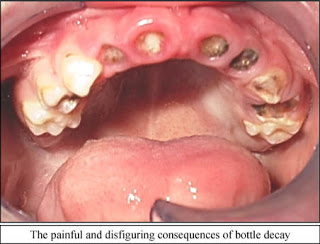
Aside from the important dental issues, commercial juices often contain preservatives or artificial sweeteners. Making homemade juice for babies is not recommended either. This is because the juice remains unpasteurized and thus can contain bacteria or other nasties which can cause serious illness (Parish 1997, Public Health and Nonpasteurized Fruit Juices).
Furthermore, as with tea, rusks and rice, juice displaces the amount of breast milk or formula a baby drinks thus compromising nutrition. Therefore it is sad but unsurprising that malnutrition and short stature in children have been associated with excessive consumption of juice (Smith and Lifshitz 1994, Excess Fruit Juice Consumption as a Contributing Factor in Nonorganic Failure to Thrive). My advice is to forget the juice. It is far easier not giving your baby sugary drinks in the first place, than to stop the habit later.
In Conclusion
From 6 months, even formula fed babies don’t need bottles. They should move onto cups. Not just from a dental viewpoint but from a speech angle too; they need to work out how to move their mouth in many different ways to eat and to talk. Use of a teat affects tongue mobility and discourages vocalisation.
The practice of putting random substances into babies’ bottles is a by-product of capitalism. The majority of babies do not need bottles, rusks, rice, juice – full stop. Yet capitalism has convinced many parents, through extensive marketing, that such products are safe, even desirable. If a baby was exclusively breastfed straight from the breast, it would be impossible to add solids to breastmilk; thus if baby was hungry or unsettled, mum would just feed for longer. This is what nature intended. It is how babies’ and mums’ bodies are designed to function and thrive.





